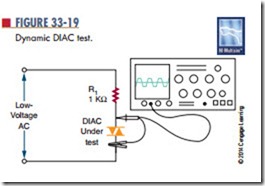testing thermistors
Like other semiconductor devices, thyristors may fail. They can be tested with commercial test equipment or with an ohmmeter.
To use commercial test equipment for testing thyristors, refer to the operator’s manual for proper switch settings and readings.
An ohmmeter can detect the majority of defective thyristors. It cannot detect marginal or voltage-sensitive devices. It can, however, give a good indication of the condition of the thyristor.
testing Scrs with an ohmmeter
1. Determine the polarity of the ohmmeter leads.
The red lead is positive and the black lead is negative.
2. Connect the ohmmeter leads, positive to the cathode and negative to the anode. The resistance should exceed 1 megohm.
3. Reverse the leads, negative to the cathode and positive to the anode. The resistance should again exceed 1 megohm.
4. With the ohmmeter leads connected as in step 3, short the gate to the anode (touch the gate lead to the anode lead). The resistance should drop to less than 1 megohm.
5. Remove the short between the gate and the anode.
If a low-resistance range of the ohmmeter is used, the resistance should stay low. If a high-resistance range is used, the resistance should return to above 1 megohm. In the higher resistance ranges, the ohmmeter does not supply enough current to keep the gate latched (turned on) when the short is removed.
6. Remove the ohmmeter leads from the SCR and repeat the test. Because some ohmmeters do not give significant results on step 5, step 4 is sufficient.
![clip_image002[1] clip_image002[1]](http://machineryequipmentonline.com/electric-equipment/wp-content/uploads/2016/02/clip_image0021_thumb1.gif) testing tRiAcs with an ohmmeter
testing tRiAcs with an ohmmeter
1. Determine the polarity of the ohmmeter leads.
2. Connect the positive lead to MT1 and the nega- tive lead to MT2. The resistance should be high.
3. With the leads still connected as in step 2, short the gate to MT1. The resistance should drop.
4. Remove the short. The low resistance should remain. The ohmmeter may not supply enough current to keep the TRIAC latched if a large gate current is required.
5. Remove the leads and reconnect as specified in step 2. The resistance should again be high.
6. Short the gate to MT2. The resistance should drop.
7. Remove the short. The low resistance should remain.
8. Remove and reverse the leads, the negative lead to MT1 and the positive lead to MT2. The resistance should read high.
9. Short the gate to MT1. The resistance should drop.
10. Remove the short. The low resistance should remain.
11. Remove the leads and reconnect in the same con- figuration. The resistance should again be high.
12. Short the gate to MT2. The resistance should drop.
13. Remove the short. The low resistance should remain.
14. Remove and reconnect the leads. The resistance should be high.
testing diAcs with an ohmmeter
![]() In testing DIACs with an ohmmeter, a low resistance in either direction indicates that the device is not opened (defective). This does not indicate a shorted device. Further testing of the DIAC requires a spe- cial circuit setup to check the voltage at the terminals (Figure 33-19).
In testing DIACs with an ohmmeter, a low resistance in either direction indicates that the device is not opened (defective). This does not indicate a shorted device. Further testing of the DIAC requires a spe- cial circuit setup to check the voltage at the terminals (Figure 33-19).
Questions
1. Describe the switch settings and indications for using a transistor tester for testing an SCR. (Refer to the manual.)
2. Describe the switch settings and indications for using a transistor tester for testing a TRIAC. (Refer to the manual.)
3. Describe the procedure for testing an SCR with an ohmmeter.
4. Describe the procedure for testing a TRIAC with an ohmmeter.
Describe the procedure for testing a DIAC with an ohmmeter.
